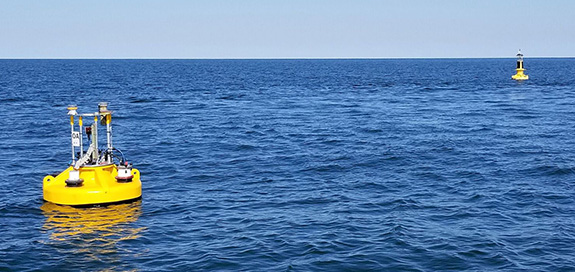NOAA and partners have launched a new buoy close to the NOAA CBIBS First Landing buoy to monitor carbon dioxide levels in the air and water as well as track pH levels in the water. The buoy, deployed by the NOAA Ocean Acidification Program, NOAA Pacific Marine Environmental Laboratory, U.S. IOOS Mid-Atlantic Regional Association Coastal Ocean Observing System, and the University of Delaware, is located near the NOAA CBIBS First Landing buoy, operated by the NOAA Chesapeake Bay Office, in order to enable collaboration with existing observations.
Updated plots of surface water and atmospheric CO2 and surface water pH are available.
Information on carbon dioxide levels is important to help scientists analyze how increasing concentrations of atmospheric carbon dioxide and increased ocean acidification affect the Chesapeake Bay--and its valuable shellfish. Carbon dioxide concentrations fluctuate greatly in the Chesapeake Bay, which receives fresh water carried by more than 150 rivers and streams in the Bay’s watershed. In carbon dioxide-rich coastal waters, research has shown that young shellfish such as oysters can have difficulty growing and surviving.
Research and modeling using measurements from sensors on the new buoy will help identify areas of the Bay that may be particularly vulnerable to increased absorption of carbon dioxide from the atmosphere, known as ocean acidification. The sensors will also help boost understanding of how large amounts of freshwater carrying fertilizer and other nutrients into the Bay may exacerbate coastal acidification.

Photo of the new "OA" ocean acidification buoy--and the nearby FL CBIBS First Landing buoy--thanks to Doug Wilson, Caribbean Wind LLC


